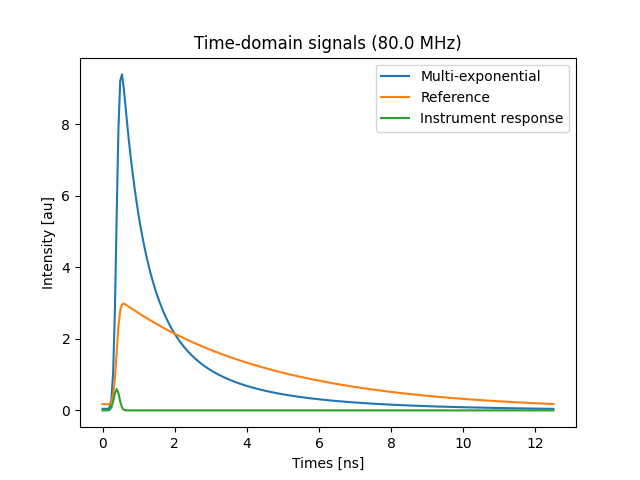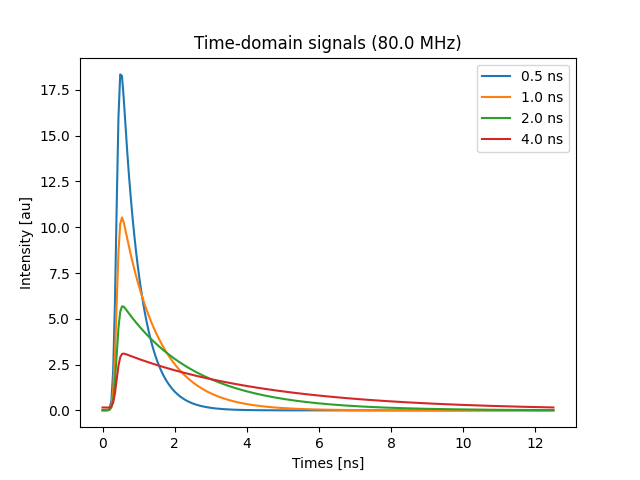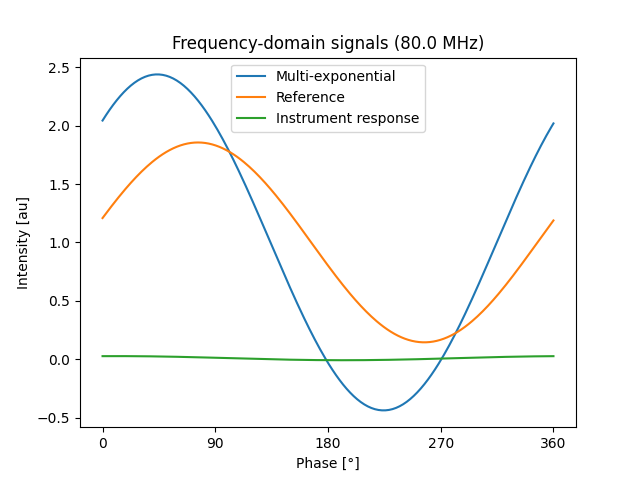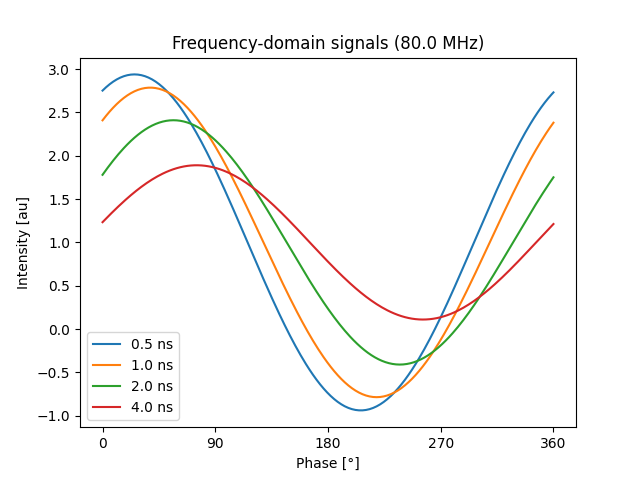Synthesize signals from lifetimes#
An introduction to the lifetime_to_signal function.
The phasorpy.phasor.lifetime_to_signal() function is used
to synthesize time- and frequency-domain signals as a function of
fundamental frequency, single or multiple lifetime components,
lifetime fractions, mean and background intensity, and instrument
response function (IRF) peak location and width.
Import required modules and functions:
import numpy
from matplotlib import pyplot
from phasorpy.phasor import (
lifetime_to_signal,
phasor_calibrate,
phasor_from_lifetime,
phasor_from_signal,
)
Define common parameters used throughout the tutorial:
frequency = 80.0 # fundamental frequency in MHz
reference_lifetime = 4.2 # lifetime of reference signal in ns
lifetimes = [0.5, 1.0, 2.0, 4.0] # lifetime in ns
fractions = [0.25, 0.25, 0.25, 0.25] # fractional intensities
settings = {
'samples': 256, # number of samples to synthesize
'mean': 1.0, # average intensity
'background': 0.0, # no signal from background
'zero_phase': None, # location of IRF peak in the phase
'zero_stdev': None, # standard deviation of IRF in radians
}
Time-domain, multi-exponential#
Synthesize a time-domain signal of a multi-component lifetime system with given fractional intensities, convolved with an instrument response function:
signal, instrument_response, times = lifetime_to_signal(
frequency, lifetimes, fractions, **settings
)
A reference signal of known lifetime, obtained with the same instrument and sampling parameters, is required to correct/calibrate the phasor coordinates of signals. The calibrated phasor coordinates match the theoretical phasor coordinates expected for the lifetimes:
reference_signal, _, _ = lifetime_to_signal(
frequency, reference_lifetime, **settings
)
def verify_signal(fractions):
"""Verify calibrated phasor coordinates match expected results."""
numpy.testing.assert_allclose(
phasor_calibrate(
*phasor_from_signal(signal)[1:],
*phasor_from_signal(reference_signal)[1:],
frequency,
reference_lifetime,
),
phasor_from_lifetime(frequency, lifetimes, fractions),
)
verify_signal(fractions)
Plot the synthesized signal, the instrument response, and reference signal:
fig, ax = pyplot.subplots()
ax.set(
title=f'Time-domain signals ({frequency} MHz)',
xlabel='Times [ns]',
ylabel='Intensity [au]',
)
ax.plot(times, signal, label='Multi-exponential')
ax.plot(times, reference_signal, label='Reference')
ax.plot(times, instrument_response, label='Instrument response')
ax.legend()
pyplot.show()

Time-domain, single-exponential#
To synthesize separate signals for each lifetime component at once, omit the lifetime fractions:
signal, _, times = lifetime_to_signal(frequency, lifetimes, **settings)
verify_signal(None)
Plot the synthesized signal:
fig, ax = pyplot.subplots()
ax.set(
title=f'Time-domain signals ({frequency} MHz)',
xlabel='Times [ns]',
ylabel='Intensity [au]',
)
ax.plot(times, signal.T, label=[f'{t} ns' for t in lifetimes])
ax.legend()
pyplot.show()

As expected, the shorter the lifetime, the faster the decay.
Frequency-domain, multi-exponential#
To synthesize a frequency-domain, homodyne signal, limit the
synthesis to the fundamental frequency (harmonic=1):
signal, instrument_response, _ = lifetime_to_signal(
frequency, lifetimes, fractions, harmonic=1, **settings
)
reference_signal, _, _ = lifetime_to_signal(
frequency, reference_lifetime, harmonic=1, **settings
)
verify_signal(fractions)
Plot the synthesized signals:
phase = numpy.linspace(0.0, 360.0, signal.size)
fig, ax = pyplot.subplots()
ax.set(
title=f'Frequency-domain signals ({frequency} MHz)',
xlabel='Phase [°]',
ylabel='Intensity [au]',
xticks=[0, 90, 180, 270, 360],
)
ax.plot(phase, signal, label='Multi-exponential')
ax.plot(phase, reference_signal, label='Reference')
ax.plot(phase, instrument_response, label='Instrument response')
ax.legend()
pyplot.show()

Frequency-domain, single-exponential#
To synthesize separate signals for each lifetime component at once, omit the lifetime fractions:
signal, _, _ = lifetime_to_signal(frequency, lifetimes, harmonic=1, **settings)
verify_signal(None)
Plot the synthesized signals:
fig, ax = pyplot.subplots()
ax.set(
title=f'Frequency-domain signals ({frequency} MHz)',
xlabel='Phase [°]',
ylabel='Intensity [au]',
xticks=[0, 90, 180, 270, 360],
)
ax.plot(phase, signal.T, label=[f'{t} ns' for t in lifetimes])
ax.legend()
pyplot.show()

As expected, the shorter the lifetime, the smaller the phase-shift and de-modulation.
TODO: generate digitized image from lifetime distributions with background and noise.
sphinx_gallery_thumbnail_number = -1 mypy: allow-untyped-defs, allow-untyped-calls mypy: disable-error-code=”arg-type”
Total running time of the script: (0 minutes 0.269 seconds)
